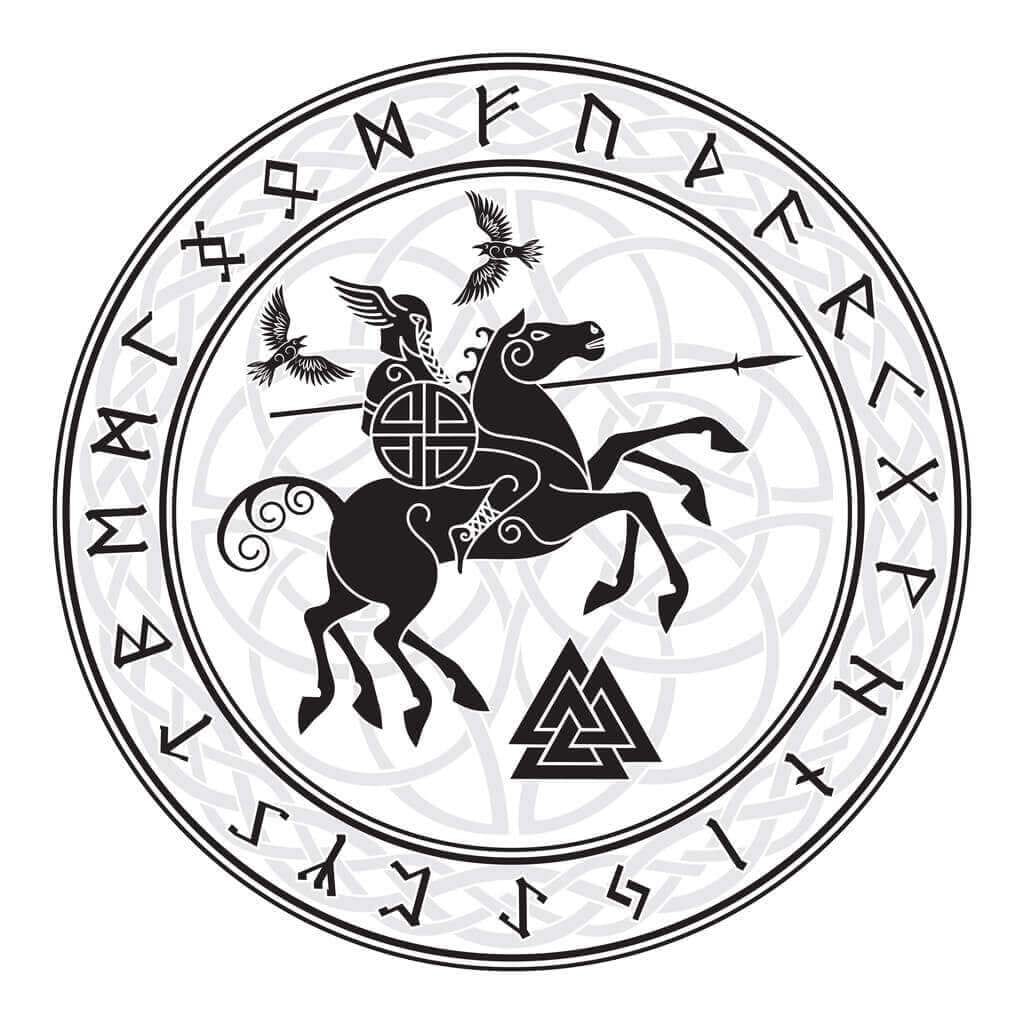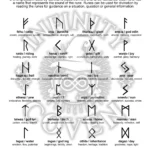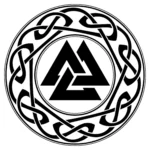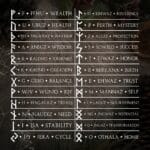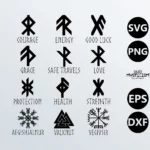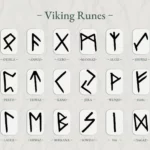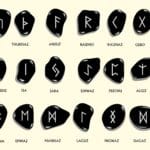Imagine stepping into a world of ancient legends, where symbols whisper secrets from the past. In Northern mythology, from the Vikings to the Anglo-Saxons, symbols weren’t just decorations. They were like keys to the unknown, unlocking the secrets of the gods, warriors, and the world itself. Runes, gods like Thor, and mysterious creatures – they all carried hidden meanings that shaped the beliefs and lives of our ancestors. Join us on a journey to uncover these enigmatic symbols, unravel their stories, and discover the wisdom that still lingers within them today.
Unveiling the Enchanting Symbols of Northern Mythology
Step into the captivating realm of Northern mythology, where symbols hold a profound and unforgettable presence. These emblems represent the core beliefs, values, and cosmic connections of the Norse people.
The Valknut: Might, Courage, and the Endless Cycle
Picture a formidable warrior’s shield. That’s the Valknut, a symbol of Odin, the revered All-Father. Its three intertwined triangles symbolize unwavering power, strength, and the eternal circle of life, death, and rebirth. It’s like a magical force field, guarding you from life’s battles.
Mjolnir: Thor’s Hammer of Thunderous Might
Prepare yourself for the thunderous blows of Thor’s mighty hammer, Mjolnir. This iconic symbol embodies the god’s incredible strength. Each swing sends a shockwave of lightning, pulverizing evil and restoring balance to the world. It’s a symbol of protection against the forces of darkness.
Yggdrasil: The World Tree Connecting Realms
Imagine a majestic tree with branches reaching into the celestial heights and roots diving into the mysterious underworld. That’s Yggdrasil, the World Tree. It’s the cosmic bridge that unites the realms of the gods, humans, and the dead. Its presence symbolizes order, growth, and the interconnectedness of all things.
Gjallarhorn: Odin’s Horn of Wisdom and Inspiration
If you’re thirsty for knowledge and eloquence, look to Gjallarhorn, Odin’s magical horn. From its depths flows the potent mead of poetry. Each sip grants the gods profound insights and the ability to weave words that stir the soul. It’s a symbol of wisdom, inspiration, and the power of language.
Table: Northern Mythology Symbols
| Symbol | Deity | Significance |
|---|---|---|
| Valknut | Odin | Power, strength, eternal cycle of life |
| Mjolnir | Thor | Immense strength, protection |
| Yggdrasil | All realms | Cosmic order, interconnectedness |
| Gjallarhorn | Odin | Wisdom, inspiration |
These symbols have transcended time, inspiring awe and wonder in people of all ages. They remind us of the values of courage, strength, and the indomitable spirit that defined the Vikings. Embrace the power and enchantment of Northern mythology symbols, and let them guide you on your journey through life.
If you’ve nurtured an interest in studying Old Norse, you’ll certainly resonate with this page about ancient norse symbols and meanings I created.
What is the significance of runes in Norse culture?
Hey there, history buff! Let’s dive into the intriguing world of runes, the ancient alphabet of the Vikings. These symbols were more than just letters; they were believed to have mystical powers. They were used for fortune-telling, shielding themselves from harm, getting better from illnesses, and even bending the course of events.
Imagine it this way: runes were like enchanted paintbrushes that could paint meaning onto anything they touched. Carved into wood, etched into stone, or inked onto skin, each rune represented a different idea or special power. Some stood for bravery, others for wisdom or guidance, and so on.
The story goes that these runes came from a magical well at the foot of a giant tree called Yggdrasil. Three goddesses called the Norns, who were in charge of fate, carried them up the tree. That’s why runes were thought to have a special link to the cosmos.
Some Key Points to Remember:
- Runes were magical symbols with special powers.
- They were used for fortune-telling, protection, healing, and influencing events.
- They were carved into things like wood, stone, or even people’s skin.
- The meaning of each rune could change depending on who was using it.
- Runes were said to have come from a magical well and were carried up a giant tree by three goddesses.
So, there you have it! Runes were not just letters; they were gateways to a world of power and meaning in Norse culture. They were a way to connect with the divine and shape the world around them.
How are Norse symbols harnessed for guidance and protection?
Have you ever marveled at the intricate designs of ancient Norse symbols, wondering about their significance? These symbols weren’t just flashy decorations; they were imbued with deep meaning and served as a guiding light for the Vikings, a hardy people who navigated treacherous seas and faced fierce battles. Let’s unlock the power they held:
Divine Guidance: Empowering the Soul
Norse symbols weren’t mere accessories. They carried immense spiritual weight. Take runes, for example. Inscribed on weapons, amulets, or even etched on their skin, these magical symbols were believed to have the power to protect, heal, and bring good fortune. Each rune represented a cosmic force, bridging the mundane with the divine.
Talismanic Guardians: Safeguarding Against Adversity
Beyond their spiritual significance, Norse symbols acted as talismans, offering protection against dangers. The Valknut, an intricate design of three interlocking triangles, symbolized Odin’s power over life, death, and rebirth. It was worn to shield warriors from harm on the battlefield. The Helm of Awe, with its mesmerizing pattern, instilled courage and ward off evil.
Cultural Echoes: Resonating in the Modern World
Even centuries later, Norse symbols continue to captivate hearts around the globe. They’ve woven themselves into the fabric of our modern culture, representing strength, resilience, and a connection to ancient wisdom. Contemporary jewelry, talismans, and even tattoos feature these symbols, reminding us of the enduring legacy of Northern mythology.
Key Points to Remember:
- Norse symbols possessed spiritual power, guiding and empowering individuals.
- They served as talismans, offering protection in battle and against evil forces.
- The legacy of Norse symbols endures in contemporary culture, connecting us to the wisdom and resilience of our ancestors.
Additional Reading:
- Explore the captivating meanings of Norse-Viking symbols: World History Encyclopedia.
What are some common Norse symbols and what do they represent?
Get ready to delve into the mystical world of Norse symbols! These enigmatic markers hold a mirror to the beliefs, values, and spiritual practices of the ancient Vikings. Prepare to be amazed as we unravel the meanings behind some of their most prevalent symbols.
Embarking on the Journey of Norse Symbols
Valknut: The Interwoven Triad
Visualize three triangles, intertwined in a harmonious dance, and you have the Valknut. This potent symbol is intertwined with Odin, the revered god of war and wisdom. It serves as a reminder of the eternal cycle of life, death, and rebirth, underscoring the choices we make along this journey.
Horn of Odin: A Vessel of Enlightenment
Picture a magnificent drinking horn, adorned with intricate carvings. This is the mighty Horn of Odin, representing the god’s limitless wisdom and inspiration. It is said that those who partake of its sacred contents, the mead of poetry, are bestowed with the gift of knowledge and the eloquence of speech.
Thor’s Hammer (Mjolnir): A Symbol of Earthly Might
Meet Thor, the formidable god of thunder, and his iconic weapon, Mjolnir. This legendary hammer epitomizes protection, unwavering strength, and the raw power of the natural world. Its presence evokes a sense of safety and the indomitable spirit of the Vikings.
Vegvisir: Navigating the Unknown
Also known as the Viking compass, the Vegvisir serves as a guiding light for those who dare to venture into the unknown. Its intricate lines and symbols are believed to protect travelers from getting lost, symbolizing the importance of hope and direction on life’s uncertain paths.
Aegishjalmr/Aegishjalmur: The Helm of Fearlessness
Prepare to encounter the Aegishjalmr, a powerful symbol known as the Helm of Awe. This protective charm is believed to grant victory in battle and shield its wearer from harm. It embodies the fierce spirit and unwavering courage that defined the Vikings.
Unraveling the Tapestry of Norse Symbols
In closing, Norse symbols are not mere decorative elements. They are threads in the tapestry of Vikings’ beliefs, values, and cultural heritage. These symbols continue to captivate us today, reminding us of the strength, resilience, and ancient wisdom that once shaped a legendary civilization.
FAQ
Q1: What meanings do Norse symbols hold?
A1: Norse symbols are deeply rooted in the spiritual and cultural beliefs of the ancient Norse and Vikings. They represent various aspects of their pantheon, such as gods, goddesses, mythical creatures, and cosmic concepts. Each symbol carries its own significance, embodying qualities like courage, strength, wisdom, protection, and connection to the divine.
Q2: What is the significance of runes in Norse culture?
A2: Runes played a crucial role in Norse culture, serving as an ancient form of written communication and divination. Each rune possesses a unique meaning and power, representing concepts such as strength, victory, wisdom, and protection. Norse people carved runes onto objects like amulets, weapons, and stones to invoke their powers and guidance.
Q3: How are Norse symbols used as a source of guidance and protection?
A3: Norse symbols were not merely decorative elements; they were believed to have potent powers and were used as sources of guidance and protection. People adorned themselves with symbols like Thor’s hammer (Mjolnir) or the Valknut to invoke the protection of the gods. Symbols were also carved onto ships, homes, and other objects to ward off evil spirits and bring good fortune.
Q4: What are some common Norse symbols and what do they represent?
A4: There is a vast array of Norse symbols, each with its own distinct meaning and representation. Some of the most well-known include:
- Valknut: Odin’s knot, symbolizing death and rebirth.
- Mjolnir: Thor’s hammer, representing strength, protection, and thunder.
- Yggdrasil: The world tree, symbolizing the cosmos and the interconnectedness of all things.
- Aegishjalmur: The Helm of Awe, a symbol of protection, strength, and invincibility.
- Vegvisir: The Viking compass, representing guidance and protection during journeys.
Q5: How can you incorporate Norse symbols into your own spiritual practice?
A5: Incorporating Norse symbols into your spiritual practice can be a meaningful way to connect with the wisdom and power of the ancient Norse. Consider using symbols as meditation aids, creating altars or sacred spaces adorned with Norse imagery, or wearing jewelry or amulets with symbolic designs. Respect and understanding of the symbols’ meanings are essential when using them in your spiritual journey.
